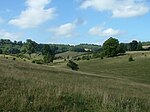Cholesbury-cum-St Leonards
Civil parishes in Buckinghamshire
Cholesbury-cum-St Leonards is a civil parish in the Chiltern district of the English county of Buckinghamshire. It lies in the Chiltern Hills just to the north of Chesham, on the boundary with Hertfordshire. It comprises the hamlet of Buckland Common, and the villages of Cholesbury, Hawridge and St Leonards (with Lane Ends hamlet) which were brought together as part of the local government reorganisation in April 1934. The parish has since increased in size through the annexing of additional parcels of land which previously were part of Chesham, Ashley Green and Drayton Beauchamp.
Excerpt from the Wikipedia article Cholesbury-cum-St Leonards (License: CC BY-SA 3.0, Authors).Cholesbury-cum-St Leonards
Cholesbury Lane,
Geographical coordinates (GPS) Address Nearby Places Show on map
Geographical coordinates (GPS)
| Latitude | Longitude |
|---|---|
| N 51.755 ° | E -0.652 ° |
Address
Cholesbury Lane
Cholesbury Lane
HP23 6ND , Cholesbury-cum-St Leonards (Chesham and Villages Community Board)
England, United Kingdom
Open on Google Maps











